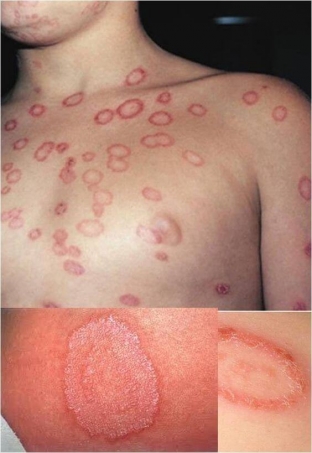Ringworm is one of the most contagious fungal infections. It is easily transmitted through contact not only from people, but also from pets, its superficial forms without proper treatment can become chronic and even in some cases take an infiltrative-suppurative form, causing a lot of suffering to patients. Provoking factors for the development of ringworm often become stress, some endocrine diseases. Read about the features of diagnosis and treatment of ringworm on estet-portal.com.
Methods of transmission of ringworm and precipitating factors of spread
The causative agents of the disease called ringworm, may be pathogenic fungi Microsporum and Trichophyton. Microsporia is most often transmitted to humans from domestic animals, and trichophytes can only parasitize on the human body. Infection usually occurs by contact-household way. Microsporia is the easiest to spread, so children 4-15 years old often complain of ringworm who caught the fungus from cats or dogs. However, the spread of ringworm can occur not only through contact with furry pets, sharing towels and combs. The infection can be obtained, say, after a visit to the hairdresser and even after close bodily contact with another person infected with the fungus.
The main provoking factor contributing to infection with ringworm is called stress and depression, which reduce the body's defenses.
In order for a parasitic fungus that has entered the skin to begin to multiply, it needs damaged skin, and this can happen under the following circumstances:
- impaired immunity due to stress,
- skin diseases,
- injuries, burns, scratches,
- softening of the skin with prolonged contact with water.
The patient should be reminded that if the skin is healthy and its integrity is intact, then even a ringworm pathogen that has got on the body will be easily washed off with water during hygiene procedures.
How not to make a mistake in diagnosing ringworm

If a fungal nature of a skin lesion is suspected, a bacteriological examination of a scraping from the focus of inflammation should be prescribed. If fungal spores are found, we can talk about ringworm.
When localizing foci on the scalp, one should keep in mind the likelihood of a favus (another type of fungus), on the body, ringworm must be differentiated from psoriasis and eczema. On smooth skin, it is sometimes confused with pink lichen, but the treatment of these diseases is completely different. It should be remembered that pink lichen, unlike ringworm, does not occur on the face, hands and feet, it resolves spontaneously after 2 months, while ringworm without treatment can give periodic relapses for years.
Deep form of ringworm may be confused with phlegmon and ostiofolliculitis. This form is very painful, the patient is very unwell, so it is important to diagnose it in time and correctly disease.
Treatment of ringworm: how to combine topical and systemic drugs
Treatment for ringworm is aimed at combating the fungus that caused the disease. A combination of systemic and local treatment is usually recommended. For example, oral griseofulvin at a dose that is calculated for the patient individually can be combined with local antifungal agents containing clotrimazole, terbinafine, ketoconazole. Topically apply creams, spray ointment, shampoo – depending on the location of the focus of ringworm.
A systemic antifungal drug is taken for 15-25 days with weekly bacterioscopic control. If the fungus is not found in the scraping, the drug is taken orally for another 14 days at the same dosage every other day.
Analysis at the end of treatment is done three times: immediately after the end of the drug, after a week, after 3 months. Only all three negative results indicate successful treatment.
If one of the tests is positive, the treatment regimen should be reviewed. It is advisable to prescribe additional drugs to strengthen blood vessels and improve microcirculation.







Add a comment